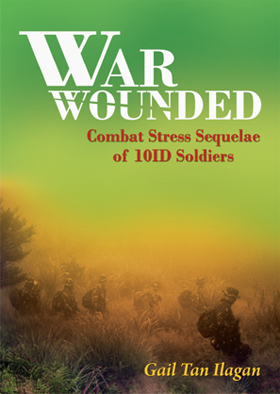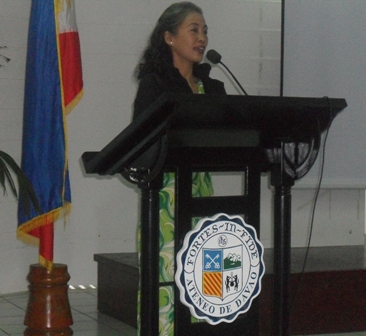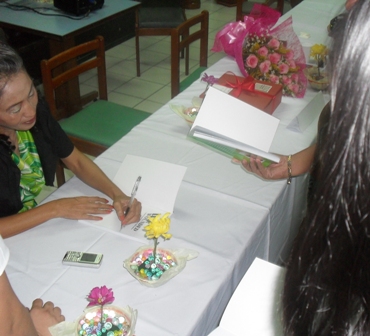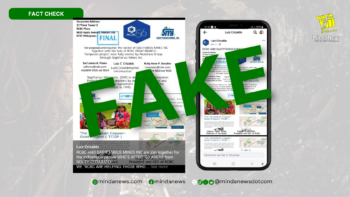DAVAO CITY (MindaNews/27 June) — “We in the military have been avoiding this topic for the longest time because we don’t know how to handle it,” Major Gen. Carlos Holganza, chief of the Army’s 10th Infantry Division, said at the launching Saturday of Dr. Gail Tan Ilagan’s book, “War Wounded: Combat Stress Sequelae of 10ID Soldiers.
”
And because they don’t know how to deal with combat stress, commonly referred to as “war shock,” Holganza says they end up joking about it: “bigyan mo na lang ng isang tambak na labada” (just give him a pile of laundry).
But Holganza knows giving a pile of laundry to a combat-stressed soldier won’t wash away the trauma. In fact, a few days ago, a soldier in Compostela Valley who had a disagreement with his wife indiscriminately fired his gun at anyone who happened to pass by, injuring several persons, one of whom suffered a heart attack and died.
“It is important for us with Gail here to be focusing on this because we have had a lot of casualties, a lot of problems,” said Holganza, head of the Army’s newest, largest and most heavily-engaged division, from where Ilagan’s research subjects came.
Lt. Gen. Raymundo Ferrer, chief of the Eastern Mindanao Command which has supervision over 10th ID among others, told the audience he was going to donate copies of the book to the AFP Medical Center to help the health professionals there handle the psychological cost of the war on soldiers.
Not understanding combat stress, he said, could lead to soldiers running amok or using their displaced aggression on non-combatants, like “nag-maoy sa videokehan” (causing trouble in the videoke bar).
Or firing their guns indiscriminately and becoming a menace to society instead of a protector.
Proposed solutions on how to handle combat stress and avoiding stressors, however, are within grasp, coming from the soldiers themselves who have experienced the same.
For instance, one of the narratives was on the 2000 battle in Matanog, Maguindanao during then President Estrada’s “all-out war” where several soldiers were killed, their bodies left unretrieved for days. There were two sets of brothers during that operation: the Dialogos and the Gomezes. Among those killed was one Dialogo and one Gomez.
The elder Gomez brother did not want to leave his younger brother behind but he was advised against going to the kill zone or be killed himself.
“We shouldn’t send brothers to the same encounter. It’s terrible when that happens,” said Ben (not his real name), who dragged the elder Gomez away from the kill zone.
Quicker medical evacuation is a common thread in the narratives of Ilagan’s book. Oftentimes, soldiers die not because they were hit by bullets but because of loss of blood from too long a wait for transport to the nearest hospital or where they could get first aid.
One of the soldiers said that in life-and-death situation, “the soldiers’ need for the helicopter should be prioritized.”
The media should know this as well as he recounted that after withdrawing from Matanog, he witnessed the anger of a Scout Ranger officer who had requested for a helicopter to evacuate the wounded but there was no helicopter sent.
 “Then we monitored on the radio that the chopper was being used to ferry the press. They were like media VIPs. Our officer was so mad. He shouted on the radio, ‘If you can’t give full support to the ground forces, I will withdraw my troops!’”
“Then we monitored on the radio that the chopper was being used to ferry the press. They were like media VIPs. Our officer was so mad. He shouted on the radio, ‘If you can’t give full support to the ground forces, I will withdraw my troops!’”
“Shouldn’t these press people have their own planes? If they want to go see what war is like, they have to do that on their own. They should think that when they are riding that chopper for the news, some soldier is bleeding away his life,” the soldier said.
Another account said the wounded were evacuated on board a habal-habal (motorcycle).
Or from an encounter site in Monkayo, Compostela Valley, “they carried me like I were a pig.
They made a hammock by tying both ends of the poncho on a stick and they carried me down like I was a roast pig. It was very painful because it would swing to and fro as they walked and sometimes they would hit me against something. I told them, ‘Put me down! I’d rather walk if I have to put up with this.’ They also carried the CAFGU that way. He was hit on the head and on the chest. He kept calling out to his bearers, ‘Go faster, have pity on my wife and children.’ Finally, we go to where there was a habal-habal. They made us ride on it.”
One soldier suggested that for combat operations of a certain size with the expectation of stiff resistance, “the Army should provide for the assignment of troops specifically for medevac so that the soldiers sent to engage could continue fighting.”
Post-operative rehabilitation is also too short. One soldier spoke of how after eight days in the hospital but still in crutches, he was immediately sent back to duty.
 Change of orders have also served as stressors. Stress is compounded “by the abrupt recalibration of mindset required when in one minute the soldier needs to stand down and in the next minute he is sent back to war,” Ilagan wrote.
Change of orders have also served as stressors. Stress is compounded “by the abrupt recalibration of mindset required when in one minute the soldier needs to stand down and in the next minute he is sent back to war,” Ilagan wrote.
One soldier said – and the others agreed – that they’d end up murmuring.
“You mutter your disagreement with the order as you set about complying. So we are murmuring under our breath even as we pull on our boots. It relieves the frustration and gets you ready to do what you have to do. But sometimes murmuring is not enough when nobody is listening. That’s why some soldiers rebel. Like the Magdalo (soldiers). Too much murmuring and nobody hearing.”
Ilagan, who teaches Social Justice, Family Sociology, Theories of Socialization and Psychology at the Ateneo de Davao University, did this pioneering research for her dissertation – “the first academic research on combat stress among active duty troops of the Armed Forces of the Philippines” not only to fulfill the doctoral requirements for Clinical Psychology (she got a Flat 1 for her dissertation) but coming from a family of soldiers, to “let the reader, especially those among us lucky enough to never know war, who will never know war, understand what it means for the soldier when we ask him to go to battle for the rest of us.”
“Let the narratives here allow the soldier a voice to purge his guilt and the venue to relive his terror without being rendered weak, vulnerable, and exposed. Let this be the venue of the warrior’s truth-telling. .. May this understanding of the psychological costs of combat exposure generate empathy and compassion for the good soldier and lend to the reader the inclination to bring the good soldier where he rightfully belongs, back here among his people.”
Ilagan, who also writes a column, Wayward and Fanciful in mindanews.com, piloted the “Torya Torya” (story-telling) module or the abbreviated narrative therapy to draw out from her subjects their stories.
The book, published by the Research and Publications Office of the Ateneo de Davao University, is available for P280 per copy at the ADDU RPO and MindaNews. (Carolyn O. Arguillas/MindaNews)
(Carolyn O. Arguillas/MindaNews)
